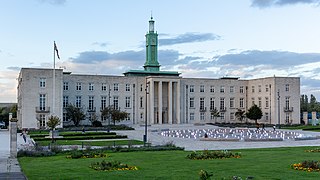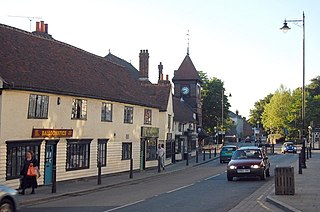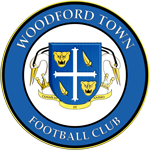
Chingford is a town in east London, England, within the London Borough of Waltham Forest. The centre of Chingford is 9.2 miles (14.8 km) north-east of Charing Cross, with Waltham Abbey to the north, Woodford Green and Buckhurst Hill to the east, Walthamstow to the south, and Edmonton and Enfield to the west. The town contains the areas of Chingford Green, Chingford Hatch, Chingford Mount, Friday Hill, Hale End, Highams Park, and South Chingford, and had a population of 70,583 at the 2021 census.

Leyton is a town in east London, England, within the London Borough of Waltham Forest. It borders Walthamstow to the north, Leytonstone to the east, and Stratford to the south, with Clapton, Hackney Wick and Homerton, across the River Lea, to the west. The area includes New Spitalfields Market, Leyton Orient Football Club, as well as part of the Queen Elizabeth Olympic Park. The town consists largely of terraced houses built between 1870 and 1910, interspersed with some modern housing estates. It is 6.2 miles (10 km) north-east of Charing Cross.

Walthamstow is a large town in the London Borough of Waltham Forest, around 7+1⁄2 miles (12 km) northeast of Central London. Traditionally part of Essex and now within Greater London for ceremonial and administrative purposes, the town borders Chingford to the north, Snaresbrook and South Woodford to the east, Leyton and Leytonstone to the south, and Tottenham to the west. At the 2011 census, the town had a population of approximately 109,424.

The London Borough of Waltham Forest is a London borough in north-east London, England. Its population is estimated to be 276,983 in 2019. It borders five other London boroughs: Enfield to the north-west, Haringey to the west, Hackney to the south-west, Newham to the south-east and Redbridge to the east, as well as the non-metropolitan county of Essex to the north.

Walthamstow Village is the oldest part of Walthamstow, east London. It was designated a Conservation Area by the London Borough of Waltham Forest in 1967, and another Conservation Area on nearby Orford Road was subsequently added. The area centres on St. Mary's Church, which was founded in the 12th century. Across the road from this is a 15th-century timber-framed hall house called "The Ancient House", which was restored in 1934 and 2002. Nearby are almshouses dating from the 16th and 18th centuries, and the Vestry House Museum, which has been used as a workhouse and police station, but has been a museum since 1931. It also holds the archives of the borough and a local studies library.

Epping Forest is a local government district in Essex, England. Situated in the west of the county, bordering northeastern Greater London, it is named after, and contains a large part of, Epping Forest.

The William Morris Gallery is a museum devoted to the life and works of William Morris, an English Arts and Crafts designer and early socialist. It is located in Walthamstow at Water House, a substantial Grade II* listed Georgian home. The extensive grounds of the building are a public park, known as Lloyd Park.

The Walthamstow Pumphouse Museum is a museum based in Walthamstow, in the London Borough of Waltham Forest. It is based in and around Low Hall Pumping Station, a Grade II listed building, originally built as a sewage pumping station in 1885.

Essex is a county in the East of England which originated as the ancient Kingdom of Essex and one of the seven kingdoms, or heptarchy, that went on to form the Kingdom of England.
Highams Park is a suburban district in the London Borough of Waltham Forest, England, near Epping Forest and 8.1 miles (13 km) north-east of Charing Cross.

Leyton was a local government district in southwest Essex, England, from 1873 to 1965. It included the neighbourhoods of Leyton, Leytonstone and Cann Hall. It was suburban to London, forming part of the London postal district and Metropolitan Police District. It now forms the southernmost part of the London Borough of Waltham Forest in Greater London.

Walthamstow was a local government district in southwest Essex, England from 1873 to 1965, around the town of Walthamstow. It was within the London suburbs, forming part of the London postal district and Metropolitan Police District. Its former area now corresponds to the central part of the London Borough of Waltham Forest in Greater London.

Waltham Forest London Borough Council is the local authority for the London Borough of Waltham Forest in London, England which has existed since the London Government Act 1963 was commenced in 1965, replacing three local authorities: Chingford Borough Council, Leyton Borough Council and Walthamstow Borough Council. It is one of London's 32 borough councils, divided into 20 wards and elects 60 councillors.

Woodford Town Football Club is a football club based in Woodford in the London Borough of Redbridge. They are currently members of the Essex Senior League and play at Ashton Playing Fields.
Philip Dalton Hepworth was a British architect. He studied in both the UK and France, at the Architectural Association School of Architecture and the École des Beaux-Arts, and returned to work as an architect after serving in the First World War. He rose to prominence in the 1930s, featuring in a book by architectural critic Trystan Edwards and winning the commission in 1932 to design Walthamstow Town Hall, which was eventually completed in 1942. Another civic building of this period was Wiltshire County Hall at Trowbridge. He also designed a handful of private houses, including Pemberley, in Loughton, 1936. He lived in Zoffany House in Strand-on-the-Green, Chiswick, London, from 1936.

Walthamstow Granada is a Grade II* listed building housing a pub, cinema and cultural centre in Walthamstow, London. The building is famous for having been frequented by Alfred Hitchcock during its time as a cinema. It was built on a site where films were shown as early as 1896.

F. G. Southgate, ARIBA, was the borough architect, engineer and surveyor, for the Municipal Borough of Walthamstow, in Essex, England, in the post-Second World War period.

The Old Town Hall is a former municipal building in Orford Road, Walthamstow, London. The building served in a municipal capacity from 1866 to 1942 and then served as the main entrance block to the Connaught Hospital from 1959 to 1977. It is a Grade II listed building.

Chingford Town Hall is a municipal building in The Ridgeway, Chingford, London. It is a locally listed building.

Leyton Town Hall is a municipal building in Adelaide Road, Leyton, London. The building, which includes Leyton Great Hall, is a Grade II listed building.

























